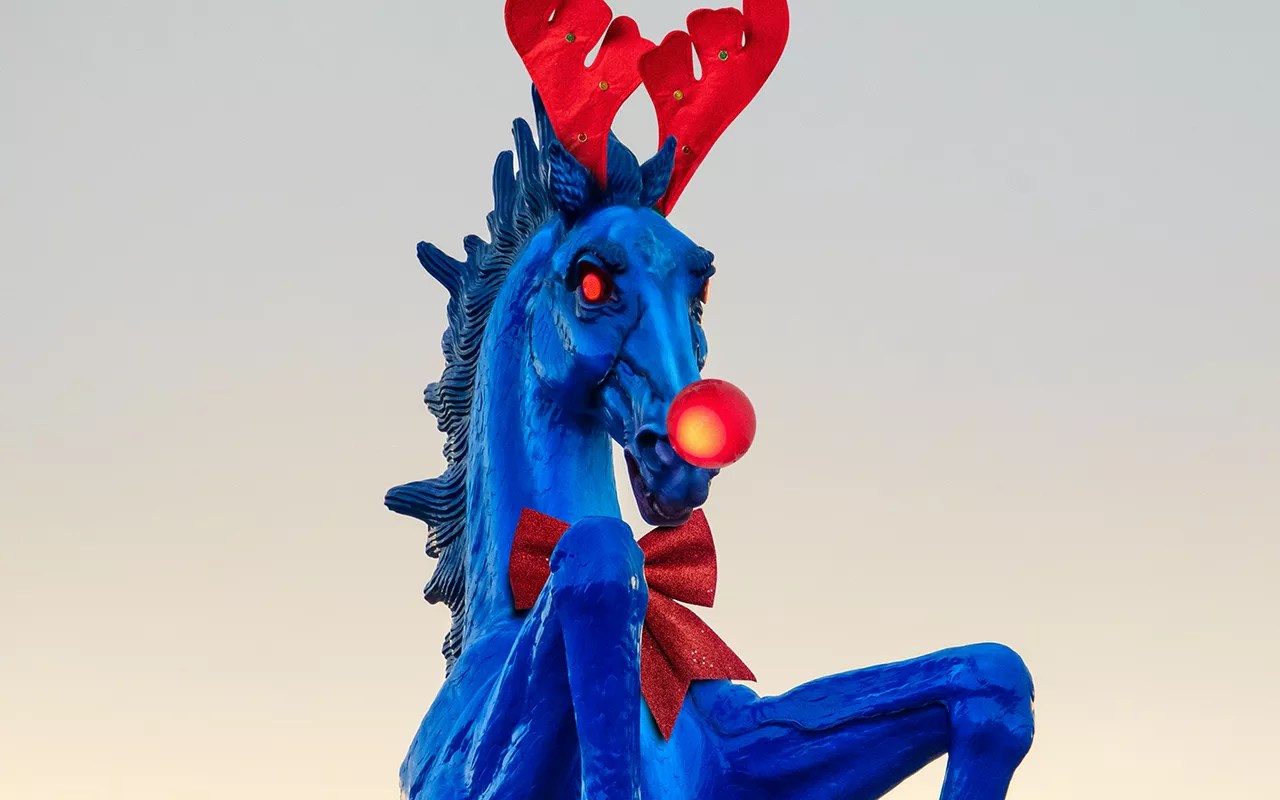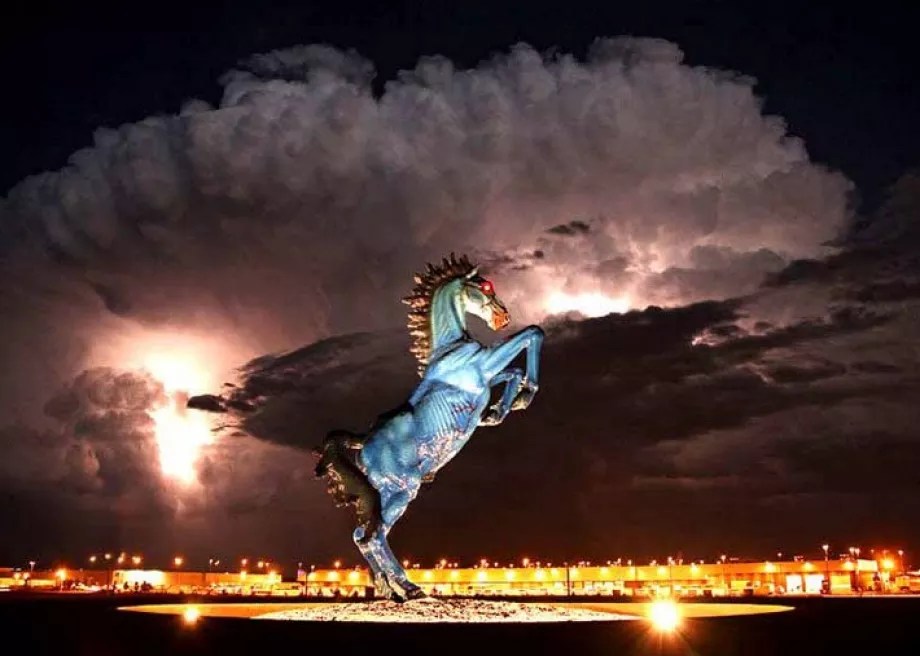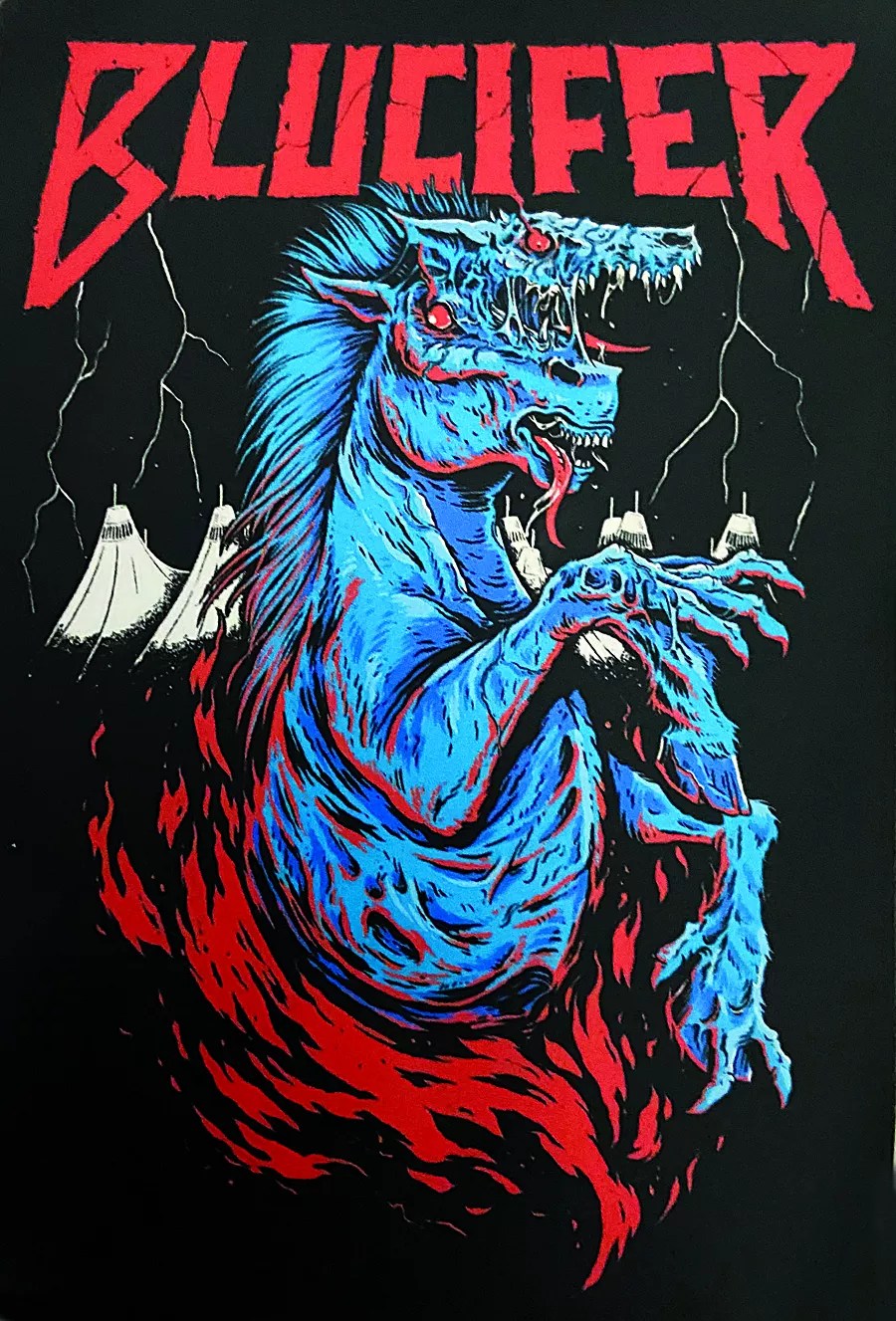
Denver International Airport/Getty Images

Audio By Carbonatix
Hundreds of thousands of travelers will pour through Denver International Airport over the holidays, encountering plenty of construction barriers but also some newly reinstalled art, including “Notre Denver,” Terry Allen’s gargoyles that once guarded the baggage-claim area and helped propel airport conspiracy theories with their creative creepiness. Still among the missing is Leo Tanguma’s “Children of the World Dream of Peace,” which carries secret messages for the New World Order or Martians, or maybe just kids dreaming of peace; like Gary Sweeney’s “America, Why I Love Her,” that mural won’t be back until the terminal renovation project is complete.
But one piece of art remains a constant, saluting departing Coloradans and welcoming visitors: “Mustang,” aka the Blue Devil Horse, aka Blucifer. (Make that Bludoph with his nose and red eyes so bright….)
In 1993, a special blue-ribbon arts committee established for the still-unopened Denver International Airport gave a $300,000 commission to New Mexican artist Luis Jiménez to create “Mustang,” a 32-foot-high fiberglass horse that was to be a centerpiece of the airport’s $7 million collection funded through the city’s One Percent for Art public-art program.
Commissions went to dozens of artists, some local – including Tanguma and Sweeney, then a baggage handler for Continental – and some international. Although Jiménez lived in neighboring New Mexico, he fell into the latter category. Born in El Paso, he’d studied art formally at the University of Texas in Austin – and informally at his father’s neon-sign studio – and was known for creating colorful fiberglass sculptures with a Southwestern flair. His proposal for the massive “Mustang” was based on his eight-foot-high “Mesteño (Mustang)” that’s now part of the University of Oklahoma collection; it recalled both the days when mustangs ran wild on the prairies and this area’s Hispanic heritage.
By the time the sculpture was finally installed on February 11, 2008 – twelve years and several threats from the city and a lawsuit later – its price had doubled to $650,000, and it had cost the life of Jiménez, who was killed in 2006 when a piece of the 9,000-pound in-the-works statue fell onto the 65-year-old artist, severing an artery in his leg. That’s when the blue horse’s devilish reputation really took off.
And once “Mustang” made its long-delayed appearance outside the airport, things didn’t settle down. One disgruntled Denver resident started a Facebook page called “DIA’s Heinous Blue Mustang Has Got to Go,” which attracted hundreds of members as well as stories in the national media. But it’s not so easy to send a piece of public art to the glue factory; under city rules, such requests can’t even be considered until five years after the work’s installation.
By then, “Mustang” had found firm footing, as perhaps the most loved – and loathed – piece of public art in
Denver.

The Denver airport has weathered a storm of controversy over “Mustang.”
Flydenver.com
Today, fifteen years after “Mustang” first reared up over DIA, it’s a local icon. So it’s no surprise that the work has inspired everything from haiku to comics to a fire-breathing Blucifer caricature.
What was a surprise was the letter sent to Abstract Denver by the Artists Rights Society, which represents the Estate of Luis A. Jiménez Jr., claiming that assorted versions of Blucifer on T-shirts and stickers sold at its stores violated intellectual property rights.
Abstract Denver is something of a local icon itself, having grown out of IndyInk, an arty screen-printer, into shops on Santa Fe Drive, inside Edgewater Public Market, at Stanley Marketplace and now at 303 16th Street, the latest incarnation of Popup Denver, a Downtown Denver Partnership program designed to enliven the core city during the pandemic whose third phase could get funding from Denver City Council any day.
In the meantime, the new Abstract Denver is exactly the kind of spot that can and should bring shoppers to what remains of the torn-up16th Street Mall, filled with creative knickknacks and items that make great souvenirs as well as gifts for Denver lifers. Owners Aaron Cohrs and Dave Roggeman are always looking for clever, creative ways to showcase local history and oddities, making deals with artists to create ever cooler products that depict the Kraken in Sloan’s Lake or bears testing plane seats high over the Stanley (a true story I heard for the first time when I visited their newest shop) or Blucifer fighting “I See What You Mean,” aka the Big Blue Bear.
Sarah Wiebenson, the DDP’s director of economic development who oversees Popup Denver, recently did some shopping there; that screen print was a big hit with her son. Abstract Denver was one of three popups introduced during phase two of the program. “They really reflect a trend we’ve seen in leasing downtown,” she says. “Denver businesses that are choosing to come downtown in their next expansion.”
While Cohrs and Roggeman are on the lookout for new work, they’re not looking for trouble. And although they considered “Mustang” fair game for artistic interpretation – after all, it’s public art paid for with public funds – they also don’t have the time or money to fight a big legal battle.
“If we had the money, or we could find anyone who would do it pro bono, I would absolutely fight it,” says Roggeman. “Denver artists need to know what they can and can’t do.”

Luis Jimenez’s estate didn’t appreciate this Blucifer art by Max Sherman.
Abstract Denver
Artists like Karl Christian Krumpholz, who received a similar legal missive when he was selling prints of his cartoon of Casa Bonita that had graced the cover of Westword back in May; that work was pulled off of Etsy, although other works remain for sale there. (Andrew Novick, the artist who tipped me off to Abstract Denver’s dilemma, happens to be the old Casa Bonita’s biggest fan; he’s just waiting to see what happens when word of Next Gallery’s show slated for February, The 2024 Casa Bonita Show – How do you like me now?, gets out.)
This is not the first time that depictions of Denver’s more famous artworks have resulted in trademark tangles. Those miniature versions of the Big Blue Bear got Visit Denver into some trouble before the organization worked out a deal with its creator, the late Lawrence Argent. Denver International Airport has never even tried to make a miniature “Mustang”; its contract with the artist was very explicit about how only two-dimensional reproductions of the work could be used, and where.
But in most cases, the artists who take off on these landmarks are celebrating them, not selling them out. Roggeman sees the artistic renderings of “Mustang” as a way to honor Jiménez, not rip off his estate. “We get to tell his story,” he points out. “We’ve always talked about the artist, and that’s what really pisses me off more than anything. I’ve probably told their dad’s story more than they have.”
Besides, Blucifer is much more than “Mustang,” he adds. “We’re celebrating it, not stealing it. That’s the whole reason we started this business…we got tired of seeing the Colorado flag on everything. Denver is so much cooler than the Colorado flag. And ours are designed by Colorado artists and printed here in Colorado.”

Get this screenprint by Alex Taylor at Abstract Denver while you still can.
Alex Taylor/5280 Custom Framing
For now, Abstract Denver is still selling the T-shirts and posters and stickers with various depictions of Blucifer. “We are selling out of what we have,” Roggeman says, “but we’d like to keep printing them. We just want to know, are we going to be okay?”
Not judging from the ARTS letter, which notes that “in order to prevent the need for formal proceedings to enforce our member’s rights, we require for Abstract to 1) promptly remove any and all reproduction of the Products from the Abstract website and all Abstract social media channels where they may be reproduced; 2) prove an accounting of all Products at issue sold; 3) refrain from selling these Products moving forward.”
Before Abstract Denver would pony up to fight the issue in an actual court, though, Roggeman wants to know what the court of public opinion would say. Can artists interpret their surroundings? Can they create arty homages to the cultural landscape? Are they free to offer their own take on “Mustang,” turning him into Bludolph or Blucifer or whatever?
Yay or neigh?